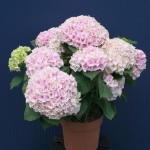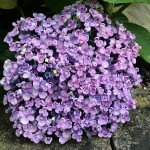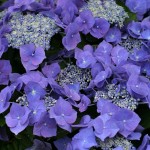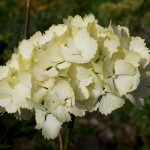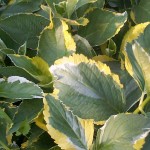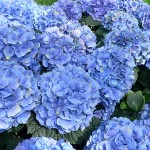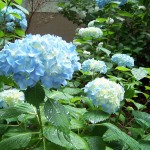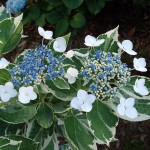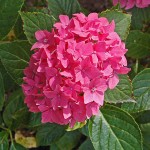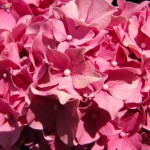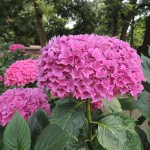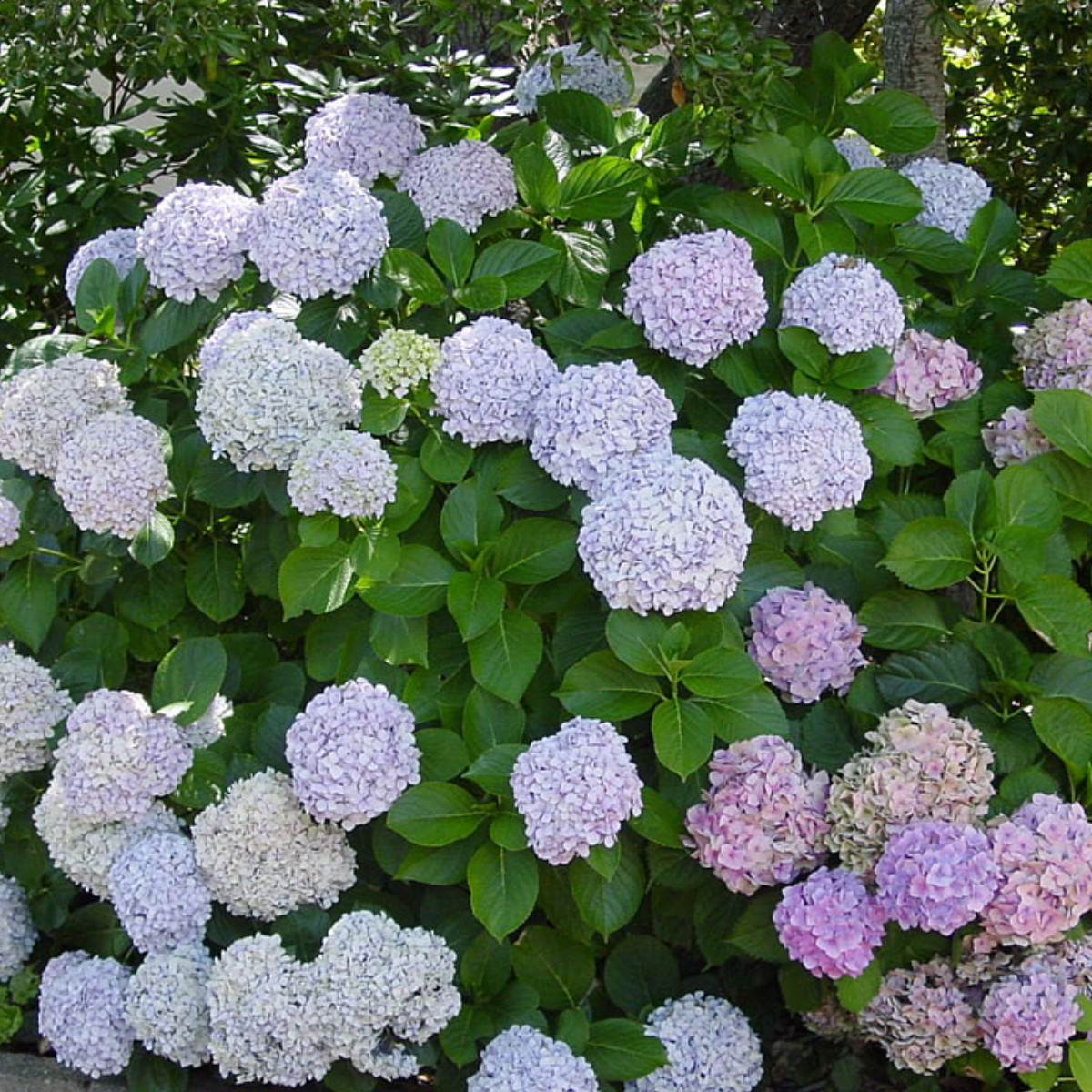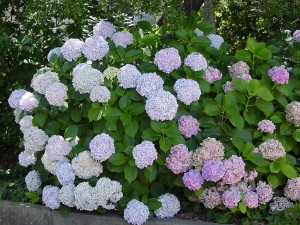Family: Hydrangeaceae
Synonymous: Hortensia opuloides
Hydrangea chungii
Hydrangea hortensia
Hydrangea hortensis
Hydrangea maritima
Hydrangea opuloides
Hydrangea otaksa
Viburnum macrophyllum
Distribution and habitat: Hydrangea macrophylla plant is native to China and Japan, growing in cool, moist, mineral rich soil and medium shade of the woodland habitats, hedgerows or stream banks. It is a deciduous shrub growing to 2m (7 feet) tall by 2.5m (8 feet) broad with large heads of pink or blue flowers in summer and autumn. It is widely cultivated as ornamental garden plant in many parts of the world in climates ranging from 6 to 9 hardiness zones.
Description: The term macrophylla means large- or long-leave. The opposite leaves can grow to 15 cm (6 inch) in length. They are simple, membranous, orbicular to elliptic and acuminate. They are generally serrated.
The inflorescence of Hydrangea macrophylla is a cluster with all flowers placed in a plane or a hemisphere or even a whole sphere in cultivated forms. Two distinct types of flowers can be identified: central non-ornamental fertile flowers and peripheral ornamental flowers, usually described as 'sterile'. The four sepals of decorative flowers have colors ranging from pale pink, red fuchsia purple to blue. The non-decorative flowers have five small greenish sepals and five small petals. Flowering lasts from early summer to early winter. The fruit is a subglobose capsule.
Hydrangea macrophylla 'Hortensia' is the most common form grown in pots. It is a low growing shrub, usually with height and spread of no more than 30-60cm (12-24 inch). Each plant has a short, woody stem and from four to eight branches, which carry opposite pairs of shiny, pointed oval leaves 8-10cm (3-4 inch) long and 5-10cm (2-4 inch) wide. The leaves have stalks about 2cm (1 inch) long. The main stem and branches may each terminate in a rounded flower head about 12-20cm (5-8 inch) wide which is composed of many four petaled flowers up to 5cm (2 inch) wide. Occasionally there are small specimens available which have only an unbranched main stem with a single flower head at its top.
Flowers of Hydrangea macrophylla 'Hortensia' have greenish buds that open white, pink, red, purple or blue. Flower colour of all Hydrangea plants are affected by the degree or acidity or alkalinity of the soil in which they grow. Pink or red-flowered kinds develop blue or purple when grown in acid or neutral potting mixtures and the normally blue-flowered kinds turn pink or purple-red in alkaline potting mixtures.
Houseplant care: Hydrangea macrophylla is the only species grown as indoor plant. Even this one is difficult to carry over from one year to another indoors because it require constantly cool conditions in order to bloom. Thus, potted Hydrangea macrophylla are usually bought when budding in early spring and may be kept for a few weeks indoors while flowering and then planted outdoors.
Light: Grow Hydrangea macrophylla plants in bright light but not too much direct sunlight.
Temperature: Flowers of potted Hydrangea macrophylla will last for up to eight weeks if kept in a cool position (below 16C). In normal room temperatures the blooms are likely to fade within three to four weeks.
Watering: Water plentifully as often as necessary to keep the potting mixture thoroughly moist. Never allow the potting mixture to dry out or the plant will collapse. If this happens, immerse the pot in a bucket of water until the root ball is thoroughly soaked. Even if this treatment succeeds, however, the current flowering period of the plant will have been shortened.
Feeding: Apply standard liquid fertiliser every two weeks as long as the plant remains indoors.
Potting and repotting: Repotting is not necessary for these temporary indoor plants. Most specimens will recover and thrive is planted in a sheltered position outdoors.
Gardening: Hydrangea macrophylla do not have to be pruned back - ever - unless they are very old. Removing dead stems is the only pruning that must be done for the health of the plant and these can be removed at any time. Hydrangea macrophylla blooms on large buds formed on previous seasons growth. Therefore is recommended do not cut the stems that are yet to flower as they will produce the first flowers of next year.
The white cultivars remain white regardless of the soil pH, but if colour changing is desired for other cultivars, lime the soil for pink flowers or add aluminum-sulphate for blue flowers. The change of the soil pH must be done before flower buds form. So treat the soil (in recommended dosage) several times at intervals starting with beginning of autumn and then again in spring. Test the soil pH concentration for good results.
Protect young plants in winter in cold zones as they are more tender than the older plants.
Location: All Hydrangea macrophylla plants will bloom and grow well in morning sun and afternoon shade in Southern Hemisphere. The further north they are grown the more sun these plants need and can withstand.
No hydrangea will do well in heavy shade such as under a shade tree. The blooms will be sparse and will not develop fully. If it is planted under a tree often fail to thrive. This is because trees roots are very aggressive and are drawn to the rich, moist soil usually provided for these plants.
Choose a location where Hydrangea macrophylla can reach its full size without pruning.
Soil: Plant Hydrangea macrophylla in well-drained soil. If the soil is heavy, add roughage such as pine bark mulch.
Do not plant it too deeply. Plant Hydrangea macrophylla in early summer or fall at the same depth the hydrangea was planted in the pot.
Transplant this plant when it has become dormant and has lost all of its leaves (late fall or winter).
Irrigation: Hydrangea macrophylla must be kept watered very well the first and second summer after they are planted or transplanted. The best way to water is deeply. Use a hose to water rather than a sprinkler system. However do not over-water. Watering every day can be just as destructive as allowing the plants to dry out. If the soil does not drain well, do not allow it to remain soggy around plants.
These plant have a moderate drought tolerance. They are not doing well in hot, dry conditions.
Fertilising: Hydrangea macrophylla grow best if they are fertilised once or twice in the summer. Either chemical fertilisers or organic matter can be used successfully. An organic method of applying manure and/or compost around the roots, produces excellent results and also improves the condition of the soil. If chemical fertilizers are used, applying a slow-release, balanced fertilizer once a year is probably the simplest solution. A less expensive fast release fertilizer such as a 10-10-10 will work just as well if applied twice during the summer. Do not fertilize after end of summer. Fall is the time for this plants to begin preparing for dormancy. Also, never fertilise a plant which looks sick.
Over-fertilisation can be much more detrimental than under-fertilization as fertiliser burn can occur when too much fertiliser is applied.
Propagation: Propagation is not practical for indoor plants. Although stem cuttings of Hydrangea macrophylla will normally root quite easily, the resultant plants are unlikely to produce flowers indoors.
For outdoors cultivation, Hydrangea macrophylla plants are easy to propagate from semi-hardwood cuttings taken from near the base of the plant, tip cuttings taken in summer or by layering, suckering or division. The cuttings 13-15cm (5-6 inch) long with the excess leaves removed should be placed in propagation mix and kept in a closed frame or sealed plastic bag until roots develop. The cuttings are taken in late summer or early fall.
Pests and Diseases:
Aphids distort the new growth and coat the leaves with sticky honeydew.
Treatment: The insects can be dislodged with a high pressure water spray from the garden hose.
Four-lined plant bug causes round, brown, sunken spots on the leaves. The injury is often thought to be a disease.
Treatment: Both contact and systemic insecticides are effective for control of these bugs.
A leaf tier webs the leaves over the tip of the branches.
Treatment: These insects may be picked off by hand. Handpick and destroy caterpillars, tell-tale rolled leaves and cocoons; prune out and destroy active webs, preferably when still small.
Rose chafers are light tan with red, spindly legs, though they can be darker.
Treatment: They can occur in large numbers where soils are sandy. Chemicals are ineffective because more rose chafers quickly move into a treated area to replace those killed by pesticides. Physically remove rose chafers, especially when small numbers are present. Remove them from plants and into pails of soapy water to kill them.
Oyster shell scale infests the upper stems of Hydrangea and often goes unnoticed.
Treatment Sprays of dormant plants with horticultural oil should help control overwintering stages and are less harmful to biological predators that help control scale.
Mites cause yellowish foliage.
Treatment: Treat affected plants with horticultural oils or an adequate pesticide following the instructions on label.
Bacterial wilt may blight the flower clusters and leaves. The disease is worse after heavy rains and hot weather. If severe, wilting and root rot occur, followed by plant death.
Bud or flower blight infects dense flower clusters in wet weather or after frost.
Several genera of fungi cause leaf spots on Hydrangea.
Powdery mildews in different genera cover the undersides of leaves with light gray mold. The leaves turn brown in spots and the upper leaf surfaces stay green or turn purplish brown. Young stems and flower stalks are infected and killed.
Rust causes rusty brown pustules on the leaves. The pustules are most noticeable on the undersides of leaves. Infected leaves dry up and become brittle.
Problems: There are three possibilities for lack of flowering among the Hydrangea macrophylla species: too much shade, improper pruning or unfavorable weather conditions which can damage the flower buds by late spring freezes.
Recommended varieties:
Hydrangea macrophylla 'All Summer Beauty' - This selection may be more appropriate for colder areas, as it supposedly blooms on current season's growth and thus will flower despite late frost damage. The profuse mophead blooms are deep blue in acid soil, and the plant grows 1.2m (4 feet) tall and wide.
Hydrangea macrophylla 'Ayesha' - Unusual for its rounded flower petals, slight fragrance and lustrous foliage, this cultivar is gaining popularity. The mophead flowers are pink-purple. This form may be less hardy than others.
Hydrangea macrophylla 'Blue Wave' - The most popular blue-flowered lacecap form, this plant is also hardier than similar plants. It grows to 2m (7 feet) tall and wide and features outer bloom florets of blue to pink (depending on soil pH).
Hydrangea macrophylla 'Golden Sunlight' - (a cultivar ofHydrangea macrophylla var. serrata) A new form that is very unusual for its new leaves which emerge golden yellow and mature to light green with age. The blooms are pinkish and the plant grows to 1m (3 feet) tall and wide.
Hydrangea macrophylla 'Lemon Wave' - Grown mostly as a foliage plant, this form has spectacular variegation -- with zones of gold, white and green on each leaf. It rarely flowers in colder zones.
Hydrangea macrophylla 'Nikko Blue' - This is the most common blue-flowered mophead form, useful in colder areas since is reportedly will produce some flowers on new growth late in the season. Acid soil will produce the deepest blue color on this 1.2 (4feet) tall shrub.
Hydrangea macrophylla 'Madame Emile Mouillere' - A hardy mophead form, this plant is also notable for its heavy production of pure white flowers that develop hints of blue-pink with age. It grows to 1.5m (5 feet) tall and wide.
Hydrangea macrophylla 'Mariesii Variegata' (may be the same as Hydrangea macrophylla 'Variegata') - This is the most common variegated leaf form, with deep green foliage edged in white. It reaches 1.5m (5 feet) tall and bears lacecap blooms, but it rarely flowers well in colder zones.
Hydrangea macrophylla 'Pia', 'Forever Pink' and 'Tovelit' - A trio of dwarf forms, these selections are among the most popular compact selections, reaching only 1m (3 feet) tall and wide. The mophead flowers are in shades of pink.
Cutting flower: Hydrangea macrophylla are used as cutting flowers as well. Their blooms can make a fabulous floral arrangements as they will fill a vase with their many tiny flowers. They also last well, especially with proper care. Properly cut blooms will last for at least several weeks to a month. It is recommended do not trim non-blooming stalks on a plant less than five years old because they tend to become next years flowers. The flower harvested should be at least a week old and is fully colored prior to cutting it since the older the bloom, the longer the cut flower will last in water. Though hydrangea leaves are pretty, they should all be trimmed off as they will steal water from the flower part and also will shorten the life of a cut flower. Consider using a shorter vase and cutting the Hydrangea macrophylla stem short, about 15cm (6 inch) or less. A longer stem requires more water and will shorten the life of the bloom. Once the bloom is cut, which should be cut on a diagonal, the Hydrangea macrophylla bloom should be immersed in water for two hours. To increase water absorption, the bottom of the stem should be either smash the with a hammer or re-cut 2.5cm (1 inch) off the bottom of the stem while it is immersed in water. This will keep the bloom alive and drinking water for a longer period of time. Since the stem will take up water, check frequently the level of water in the vase. Change the vase water every few days.
Dry flowers: Hydrangea macrophylla can be used as dried flowers. While it is tempting to cut the hydrangea blossoms for drying at the height of their color, this does not work. Fresh, recently opened blooms, rarely dry well in the open air. Hydrangeas do best when allowed to dry on the plant before picking them. In the south, hydrangeas usually age to a blushing green color and then pick up shades of pink and burgundy as Fall approaches. In the cooler areas of the world, they seem to age to shades of blue and purple. They are both equally beautiful, but very different.
Leave blooms on the shrub until late summer. Toward the end of the summer the petals will begin to age and take on a vintage look. If left on the shrub a little longer, many blooms will pick up interesting shades of burgundy and pink.
Another method: If are used cut blooms to dry, strip off the leaves, arrange them in a vase, with or without water, and leave them to dry. It is not necessary to hang hydrangea flowers up side down to dry unless the stems are very thin and weak.
To retain extremely natural hydrangea color, use Silica Gel to dry fresh blooms.
Uses: Hydrangea macrophylla is a useful hedging plant because of its vigorous growth. It is an appreciated shrub border for its high quality foliage, adding textural variety to a landscape. It makes a stunning plant for either specimen, groupings or mass plantings. It is suitable for cottage garden style. Also, it can be used as container plant or above-ground planter.
Hardiness zone: 5b - 9a
